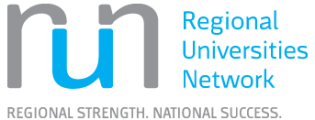A new economic impact study for the Regional Universities Network (RUN) has found that its seven regionally headquartered universities are a driving force in regional economies.
The Chair of RUN, Professor Helen Bartlett, said the Economic Impact of the Regional Universities Network study by Nous and the Centre of Policy Studies showed that in 2018, RUN universities contributed $2.4 billion to real GDP in regional Australia and created 11,300 jobs, a 41 per cent increase since 2015.
“Scenario modelling has demonstrated that the greater the investment in regional universities, the greater the benefits to regional Australia,” Professor Bartlett said.
“The Job-ready Graduates legislation will have a positive impact in the regions through funding for more places and regional research, and if passed by the Senate, will help grow regional economies.
“If 6,000 more students from regional, rural and remote NSW, Victoria and Queensland attended RUN universities, an additional 690 jobs would be generated and $122 million more contributed to real GDP.
“This broadly equates with the impact the 3.5 per cent growth in places the Job-ready Graduates legislation will deliver at regional campuses,” Professor Bartlett said.
“Seven out of 10 RUN undergraduates go on to work in regional Australia, compared to 2.5 out of 10 of non-RUN undergraduates.
“RUN plays an important role in filling the demand pipeline for key industries in regional Australia.
“In 2019, nearly half of all RUN graduates went on to work in the health care, social assistance and education and training industries, those which are expected to grow the most over the next five years.
“In 2018, more than 40 per cent of RUN students studied health and education courses,” Professor Bartlett said.
“Roughly doubling RUN research income from its 2018 level to $253 million would generate an additional $94 million in real GDP across RUN’s regional campus areas and an additional 600 jobs.
“The new $50 million regional research fund under Job-ready Graduates would have a little under half this impact.
“If each RUN university received a once-off capital investment valued at $50 million, an additional 900 ongoing jobs, not including one-off construction jobs, would be generated and $140 million more contributed to real GDP,” Professor Bartlett said.
“More broadly, RUN member universities act as anchor institutions within their regions, affecting the size of the local population.
“As universities grow over time, more people are attracted to the region by university jobs, which in turn supports employment in other industries.
“Increased population in a region due to the presence of a university generates a possible $2.9 billion and 15,700 jobs,” Professor Bartlett said.
The findings of the Economic Impact of the Regional Universities Network study can be found at: www.run.edu.au/resources/RUN_Findings_Report_final_.pdf
For a summary of the study findings, visit: www.run.edu.au/resources/RUN_Summary_Report_final_.pdf
Notes to editor:
Key findings of the study are provided below.
Images available on request.
Audio grabs available through Radio Release® or on request.
Contacts:
Dr Caroline Perkins, Executive Director, RUN, 0408 482 736
Bernadette Smon, Media Adviser, RUN, 0478 495 457
Website: www.run.edu.au
Twitter: @RegUniNet
Facebook: www.facebook.com/regionaluniversitiesnetwork
Hashtag: #RegUnisHelpRegions
RUN Economic Impact Study Key Findings
In 2018, RUN universities:
- contributed $2.4 billion to real GDP in regional Australia in 2018, an increase of 41 per cent since 2015
- created 11,300 jobs in the regions
- increased real wages by 1.3 per cent in campus regions
- spent $2.5 billion, mostly at regional campuses
- enrolled 135,400 students at regional campuses
- received a research income of $124 million and undertook research that was above or well-above world standard in 34 broad fields of research, including medical and health services, psychology and cognitive sciences, agricultural and veterinary sciences, environmental sciences, mathematical and chemical sciences.
In 2018/19, RUN graduates:
- largely worked in regional Australia – seven out of 10 of RUN undergraduates stayed in the regions to work, compared to 2.5 out of 10 of non-RUN undergraduates
- worked in industries experiencing employment growth – six out of 10 RUN graduates found employment in health, education and professional services in regional Australia and 40 per cent of students studied health and education courses
- earned $235,000 more in lifetime earnings that non-degree holders from campus regions.
Scenario modelling:
- if 6,000 more students from regional, rural and remote NSW, Victoria and Queensland attended RUN universities, an additional 690 jobs would be generated and $122 million more contributed to real GDP
- doubling RUN research income to $253 million would generate an additional $94 million in real GDP across RUN’s regional campus areas and an additional 600 jobs
- if each RUN university received a once-off capital investment valued at $50 million, an additional 900 ongoing jobs, not including one-off construction jobs, would be generated and $140 million more contributed to real GDP
- increased population in a region due to the presence of a university generates a possible $2.9 billion and 15,700 jobs.
